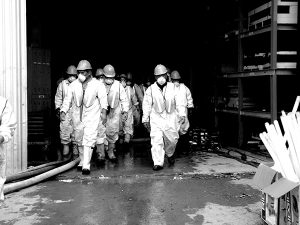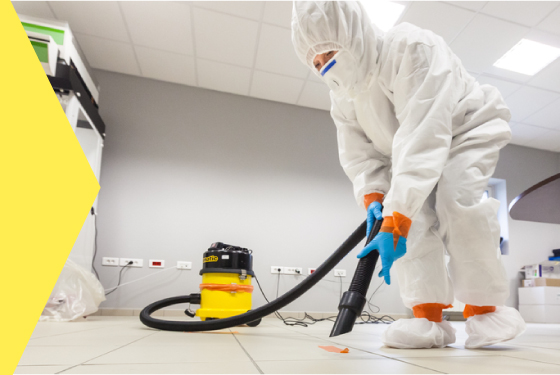Biohazard Removal: Safe Handling and Disposal of Hazardous Products
Specialist Biohazard Clean-up for Criminal Offense Scenes, Trauma Incidents, and Contaminated Spaces
In the realm of expert biohazard cleanup, meticulous focus to detail and adherence to safety and security methods are critical. When faced with the consequences of a criminal offense scene, trauma incident, or any kind of polluted space, the value of correct clean-up can not be understated. The complexities and dangers connected with biohazards need specific expertise and proficiency to ensure effective removal. As we delve into the intricacies of biohazard cleanup for these delicate atmospheres, a much deeper understanding of the difficulties and crucial procedures involved will arise, losing light on the crucial duty of expert cleanup services in bring back safety and security and satisfaction.

Importance of Biohazard Cleanup
Biohazard cleanup complying with criminal offense scenes and injury occurrences is crucial for ensuring the safety and security of people and the atmosphere. When these events take place, they typically leave a variety of biohazards such as blood, bodily liquids, and other potentially transmittable products. These compounds can harbor dangerous virus like germs and infections, positioning significant health risks if not properly cleaned and sterilized.
Expert biohazard clean-up services are educated to handle these harmful products securely and properly. They have the necessary devices, such as individual safety equipment and specialized cleansing representatives, to thoroughly sanitize the affected locations. By delegating the cleaning to qualified specialists, people can avoid direct exposure to hazardous microorganisms and stop the spread of contagious diseases.
In addition, correct biohazard clean-up is vital for safeguarding the setting. Inappropriate disposal of biohazardous materials can pollute soil, water sources, and air, presenting a threat to wild animals and the ecological community. By adhering to strict cleaning protocols, experts can ensure that biohazards are safely removed and gotten rid of in conformity with laws, reducing the danger of ecological contamination.
Types of Biohazards Encountered
Numerous dangerous products commonly run into in criminal activity scenes and injury cases existing considerable health and wellness risks if not managed correctly. Blood and bodily fluids are among the most common biohazards found in these scenarios.
An additional kind of biohazard typically experienced is sharp objects like needles, damaged glass, and various other items that can create injuries and transfer infections. Chemical risks are likewise a problem, as criminal offense scenes might contain substances like tear gas, pepper spray, or medicine manufacturing materials that call for customized handling and disposal procedures to prevent more harm.
Additionally, mold and mildew and germs development can happen in spaces where disintegration or long term direct exposure to wetness has actually taken place. These microorganisms can release toxic substances and irritants into the air, presenting breathing threats to those revealed. In general, biohazard clean-up experts must be skilled and fully equipped to successfully manage these various kinds of unsafe materials to guarantee the safety of themselves and others.
Tools and Protective Gear
When resolving the essential job of managing biohazards experienced in crime scenes and trauma occurrences, the utilization of correct equipment and protective equipment is vital to making certain the safety of individuals associated with the clean-up process. Personal safety devices (PPE) such as handwear covers, safety glasses, coveralls, and masks are vital to stop straight contact with possibly hazardous substances. Respirators are vital when managing biohazards that may become air-borne, shielding workers from inhaling unsafe fragments. Specialized cleansing tools like biohazard anti-bacterials, sharps, and bags containers are required for the safe collection and disposal of contaminated products. Furthermore, sturdy tools such as industrial-grade cleaner, foggers, and ozone generators may be called for to thoroughly sanitize the damaged area. Making sure that all equipment is effectively kept, frequently inspected, and utilized according to security guidelines is essential in reducing the danger of exposure to biohazards during clean-up operations.
Clean-up Refine and Methods
Efficient and thorough cleanup of biohazardous products from crime scenes and trauma events needs meticulous attention to information and visite site adherence to stringent safety protocols. The cleanup process typically involves numerous vital steps. At first, the location must be examined to identify the extent of contamination and the appropriate cleansing strategies needed. Next off, all biohazardous products, consisting of blood, bodily liquids, and tissue deposits, have to be very carefully removed and thrown away in conformity with regional guidelines.
Adhering to the elimination of biohazardous products, the afflicted area undertakes an extensive cleaning clean up blood from carpet and sanitation procedure. This step entails the use of specialized cleansing agents and tools to make sure that all traces of contamination are gotten rid of. After cleaning, the area is subjected to rigorous testing to validate that it is free and risk-free of any type of remaining biohazards.

Purification and Disposal Treatments
To make sure detailed decontamination and correct disposal of biohazardous products, complying with the careful cleanup process, certain treatments need to be meticulously adhered to with stringent adherence to safety and security protocols. Purification includes the elimination or neutralization of impurities to reduce the danger of exposure and spread of harmful compounds. This process commonly consists of cleaning, decontaminating, and sterilizing the damaged area making use of specialized equipment and EPA-approved chemicals.
As soon as decontamination is completed, proper disposal of biohazardous products is vital to prevent additional contamination or damage. Biohazardous waste, such as blood-soaked materials or physical fluids, must be thoroughly gathered, packaged, and identified according to regulative guidelines. ATP testing. These products are then transported to licensed facilities for disposal crime scene cleanup equipment supplies with suitable networks, guaranteeing compliance with regional, state, and federal laws

Conclusion
Finally, professional biohazard clean-up is vital for making certain the safe and efficient elimination of hazardous materials from criminal offense scenes, injury cases, and polluted areas. By utilizing specialized devices, protective gear, and following appropriate clean-up processes and strategies, biohazard cleanup groups can efficiently sanitize and dispose of biohazards, lessening the threat of direct exposure and harm to people and the environment.
As we dive into the ins and outs of biohazard clean-up for these delicate atmospheres, a deeper understanding of the challenges and essential procedures entailed will certainly arise, dropping light on the vital duty of specialist clean-up solutions in restoring safety and security and tranquility of mind.
Specialist biohazard cleanup solutions are trained to handle these harmful materials securely and effectively. By complying with rigorous clean-up methods, professionals can make certain that biohazards are safely gotten rid of and disposed of in conformity with guidelines, lessening the threat of ecological contamination.
Overall, biohazard cleaning specialists need to be fully equipped and experienced to successfully deal with these different types of harmful materials to ensure the security of themselves and others.
When dealing with the crucial job of managing biohazards experienced in criminal offense scenes and injury occurrences, the use of proper tools and safety gear is critical to ensuring the safety of individuals included in the cleaning procedure.